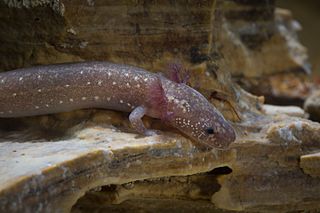
The Barton Springs salamander is an endangered lungless salamander. It is endemic to Texas, United States. It was first found in Barton Springs in Austin, but is now also known from other localities in the nearby Travis and Hays Counties. Barton Springs salamanders are average-sized and have mottled coloration varying from darkish purple to light yellow.
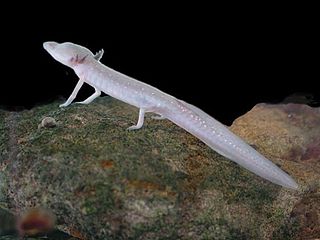
The Texas blind salamander is a rare cave-dwelling troglobite amphibian native to San Marcos, Hays County, Texas, specifically the San Marcos Pool of the Edwards Aquifer.
The blunt-headed Salamander is a mole salamander endemic to Mexico. It is only known from the vicinity of its type locality, near Morelia, in Michoacán state in Southwestern Mexico. It inhabits a landscape consisting of a mosaic of natural grasslands and pine-oak forests at elevations of about 2,000 m (6,600 ft) asl). Breeding takes place in ponds.
The Cascade Caverns salamander, or Cascade Caverns neotenic salamander, is a species of aquatic salamander endemic to Cascade Caverns in Kendall County, Texas. Like other species of cave salamanders, they are almost entirely subterranean, living in spring waters deep in limestone rock strata, so gauging the exact extent of their geographic range or even their population numbers is virtually impossible. This also leads to reduced sampling for study, which has led to some uncertainty in the taxonomic classification; some sources consider all species of Texas cave salamanders to be subspecies of the Texas salamander. Eurycea neotenes and Eurycea rathbuni also live in caves and eat small insects and spiders.
The Valdina Farms salamander is a species of aquatic salamander described from Valdina Farms Sinkhole in Medina County, Texas, United States. It is sometimes referred to as the Valdina blind salamander or sinkhole salamander. As some other species of Eurycea found in Texas, it was once classified as a subspecies of the Texas salamander, Eurycea neotenes, and believed to possibly be the result of hybridization with another species of subterranean salamander, but was granted full species status in 2000. Research is ongoing, and some sources suggest the current species may actually be multiple distinct species.

The San Marcos salamander is a small species of aquatic, lungless salamander native to the United States, endemic to Spring Lake and a small region of the headwaters of the San Marcos River near Aquarena Springs, in Hays County, Texas. It is one to two inches long, with a slender body and external gills, and is a reddish-brown in color.
The Comal blind salamander or Honey Creek Cave blind salamander is a small species of aquatic, lungless salamander native to the United States. It is endemic to a small region at the junction of Comal, Bexar and Kendall Counties in Texas. It is 1.5 to 3.0 in long, with a slender body and external gills, and is an overall translucent pink color.
The Blanco blind salamander is a species of aquatic, lungless salamander native to the United States. It is endemic to a small region of the Blanco River near San Marcos in Hays County, Texas. Its habitat, deep in limestone karst, makes collecting specimens for research particularly problematic. It is known from only a single specimen, collected in the 1950s.
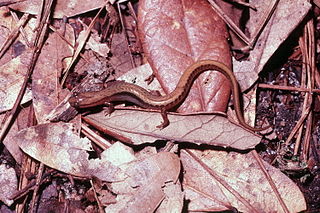
The dwarf salamander is a species of salamander native to the southern United States, from North Carolina to Oklahoma, south to Texas along the Gulf of Mexico states to northern Florida. Some sources refer to it as the four-fingered manculus, dwarf four-toed salamander, or the Florida dwarf salamander.
The Salado Springs salamander is a species of salamander in the family Plethodontidae. It is endemic to the vicinity of Salado, Texas.

The Georgetown salamander, also known as the San Gabriel Springs salamander, is a species of salamander in the family Plethodontidae. It is endemic to springs in Williamson County, Texas, near Lake Georgetown. It inhabits freshwater springs and, possibly, caves. It is threatened by habitat loss. Many of the springs where this species formerly lived have been destroyed by development, including creation of Lake Georgetown. The specific name refers to the few remaining remnants of habitat for this species.
The fern bank salamander, also known as the Blanco River Springs salamander, is a species of salamander in the family Plethodontidae. It is endemic to springs in the Blanco River watershed in central Texas, United States.
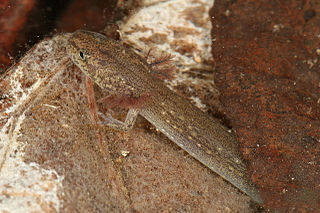
The Jollyville Plateau salamander is a species of salamander in the family Plethodontidae. It is also known as the Tonkawa Springs salamander. It is endemic to Travis and Williamson counties, Texas, United States. This species is perrenibranchiate, retaining its gills throughout life.
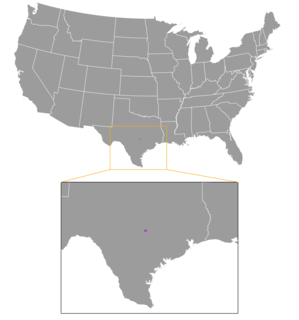
The Austin blind salamander is an endangered species of salamander in the family Plethodontidae, endemic to Barton Springs in Austin, Texas, United States. Its name is derived from Waterloo, the original name of Austin.
The Georgia blind salamander is a species of salamander in the family Plethodontidae. It is endemic to the south-eastern United States where its natural habitats are inland karsts, caves and subterranean habitats. It is listed as "Vulnerable" by the IUCN and is threatened by habitat loss.

The grotto salamander, also called the Ozark blind salamander, is a species of salamander in the family Plethodontidae. It is now considered a member of the genus Eurycea, but was originally described as Typhlotriton speleus. It is endemic to the United States, specifically the karst regions beneath the Springfield and Salem Plateaus of the Ozark Mountains part of Arkansas, Kansas, Missouri, and Oklahoma. Its natural habitats are freshwater springs, inland karsts, and caves. It is not currently threatened, but vulnerable to changes in groundwater quality and reduction in bat population.








